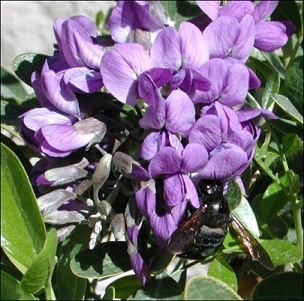
Mountain Laurel blossoms hang like clusters of grapes, filling the air with an irresistible scent. You lean forward to better enjoy the perfume—when you realize that a huge, black bee is inches from your nose. Panic time? Nope, it's just a carpenter bee, gathering nectar and pollen—and almost as harmless as a fly.
But, a carpenter bee? What does it build, hives? Not these bees. They
construct tunnels in wood, where each female packs away the provisions so industriously
gathered and lays her eggs, protected from most predators. Although sometimes damaging
man-made structures, these insects usually bore into such things as the dry flower
stalks of yuccas and agaves. These carpenters once were thought to be only nectar
thieves, cutting through the base of flowers with no payment to the plant. We now know,
however, that they actually do a good job of pollination for many plants such as
Ocotillo and Mountain Laurel, and in these cases they have reached that exalted state
of neighborliness known as mutualism. 
Listen to the Audio (mp3 format) as recorded by KTEP, Public Radio for the Southwest.
Contributor: Arthur H. Harris, Laboratory for Environmental Biology, Centennial Museum, University of Texas at El Paso.
Desert Diary is a joint production of the Centennial Museum and KTEP National Public Radio at the University of Texas at El Paso.

Carpenter Bee feeding on Mountain Laurel. Photograph by A. H. Harris.
Phillips, S. J., and P. W. Comus, editors. 2000. A natural history of the Sonoran Desert. Arizona-Sonora Desert Museum Press, Tucson, 628 pp.
General Information (Wikipedia)